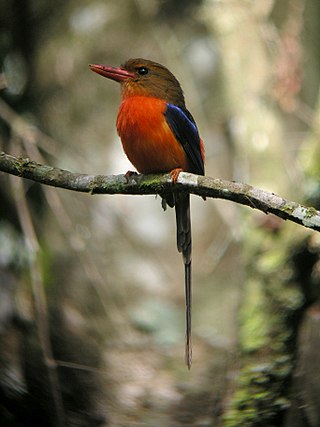
The Indian peafowl, also known as the common peafowl or blue peafowl, is a peafowl species native to the Indian subcontinent. While it originated in the Indian subcontinent, it has since been introduced to many other parts of the world. Male peafowl are referred to as peacocks, and female peafowl are referred to as peahens, although both sexes are often referred to colloquially as a "peacock".

Bandhavgarh National Park is a national park of India, located in the Umaria district of Madhya Pradesh. Bandhavgarh, with an area of 105 square kilometres (41 sq mi), was declared a national park in 1968 and then became Tiger Reserve in 1993. The current core area is spread over 716 square kilometres (276 sq mi).

Sultanpur National Park (formerly Sultanpur Bird Sanctuary) is located at Sultanpur village on Gurugram-Jhajjar highway, 15 km from Gurugram, Haryana and 50 km from Delhi in India. This covers approximately 142.52 hectares.

Ras Al Khor Wildlife Sanctuary is a wetland reserve in Dubai, renowned for attracting large numbers of migratory birds. It is also home to a large population of crustaceans, small mammals, and fish. It was the end of Dubai Creek before the construction of Dubai Canal, hence the Arabic name which literally means "the head of the creek".
Bankapura is a panchayat town in Haveri district in the state of Karnataka, India. It is in Shiggaon taluk, is just 2.5 km from the Pune-Bangalore national highway NH-4, 22 km from Haveri town. Bankapura is about 45 km from Hubli-Dharwad. An historical site, Bankapura is famous for the Nagareshwara temple, Bankapura fort, The Bankapura Peacock Sanctuary. Baada, the birthplace of Kanakadasa is near to Bankapura.

Karnataka, the sixth largest state in India, was ranked as the third most popular state in the country for tourism in 2014. It is home to 507 of the 3600 centrally protected monuments in India, second only to Uttar Pradesh. The State Directorate of Archaeology and Museums protects an additional 752 monuments and another 25,000 monuments are yet to receive protection.

The state of Karnataka in South India has a rich diversity of flora and fauna. It has a recorded forest area of 38,720 km2 which constitutes 55% of the geographical area of the state. These forests support 25% of the elephant population and 20% of the tiger population of India. Many regions of Karnataka are still unexplored and new species of flora and fauna are still found.

The paradise kingfishers are a group of tree kingfishers endemic to New Guinea — with the exception of two species also present in the Moluccas and Queensland.

Hastinapur Wildlife Sanctuary is a protected area in the Gangetic plains of Uttar Pradesh, India. It was established in 1986 and covers 2,073 km2 (800 sq mi) across Meerut, Muzzafarnagar, Ghaziabad, Bijnor, Meerut and Amroha districts. This area has not enjoyed protection needed to check poaching and various other threats to wildlife due to lack of proper notification.
Saman Bird Sanctuary is a wetland in Mainpuri district, in western Uttar Pradesh. Located in the village of Saman, it has been designated as a protected Ramsar site since 2019.

The Sita Mata Wildlife Sanctuary is a wildlife sanctuary situated in Pratapgarh and Chittaurgarh districts of Rajasthan Rajasthan, India, declared as a protected forest area by the Government of Rajasthan Notification No. F 11 (9) Revenue/8/79, dated 2/11/1979. It is a dense forest, with an area of 422.95 square kilometers, which is about 40% of the total land area of the district. The land is undulating because of the confluence of three different formations — Malwa Plateau, the Vindhyachal Hills and Aravali mountain ranges.

Housing more than 200 resident and wintering bird species, Chennai has long been a haven for bird watchers. It is one of the few urban areas in India with diverse range of birds including greater flamingo, black baza, osprey, Indian eagle-owl, Coppersmith barbet, Spot billed pelican and pied avocet can be seen. The following are some known birding hotspots in and around Chennai.

Chintamoni Kar Bird Sanctuary (CKBS), formerly known as Kayaler Bagan, is a bird sanctuary located in West Bengal, India, south of Kolkata. This garden is famous for its wide variety of birds, butterflies, ferns and orchids.

Kongur is a freshwater wetland located in Tirupur District, Tamil Nadu, India.

The Deer Park, Hisar, on Hisar-Dhansu in Hisar city of Haryana state in India has an area of 19 hectares including a 6-acre plot for producing fodder for the deer. Park as 4 species, blackbuck, chital spotted deer and 6 sambar. It also doubles up as the wildlife rescue clinic for the treatment injured wild animals and birds brought here by the people, which are released back in to the wild after the recovery.
Blue Bird Lake, Hisar is a resident and endangered migratory bird wetland habitat, lake and recreation area in the town of Hisar, in the Hisar district of Haryana State, India.
Madhu Road National Park is a national park in northern Sri Lanka, approximately 25 km (16 mi) east of Mannar.

The Sukhna Wildlife Sanctuary is a 2600 hectare nature preserve located in the Shivalik Hills of Chandigarh, India, near Sukhna Lake. The area was officially declared a wildlife sanctuary in 1998. The sanctuary is open for a select number of visitors, and an entry pass is required, which is issued by the Forest Department Office. The reserve is typically not open to the public during the rainy season.

Idukki Wildlife Sanctuary is Wildlife Sanctuary located in Idukki district of Kerala, India. Situated around the catchment area of Idukki Dam, the Idukki Wildlife Sanctuary is rich in biodiversity and rich flora and fauna.

















